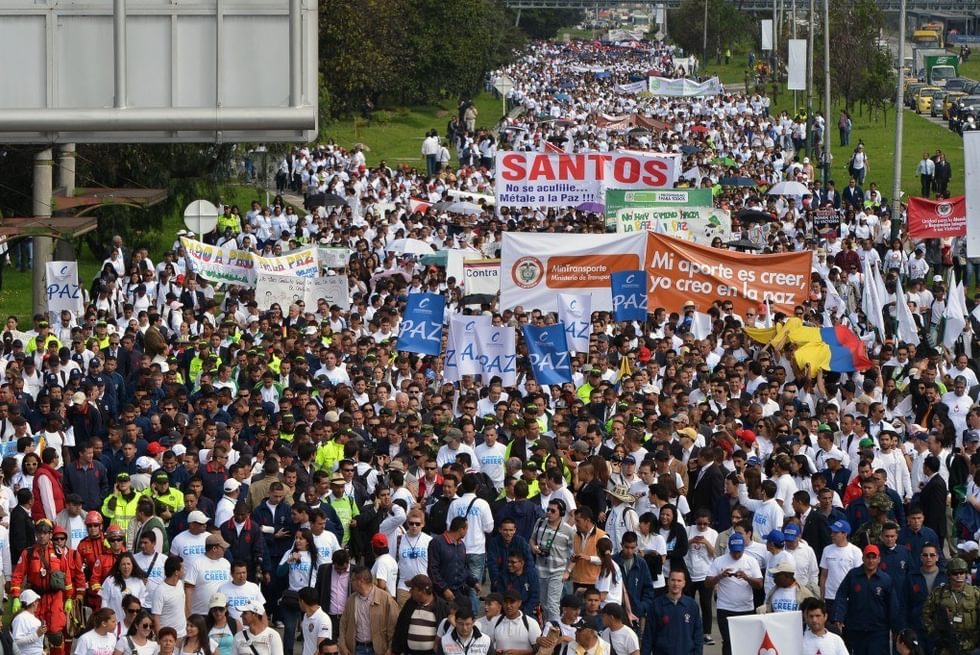Peace Negotiations and Social Protest
From the Series: The Colombian Peace Process: A Possibility in Spite of Itself
From the Series: The Colombian Peace Process: A Possibility in Spite of Itself

The Revolutionary Armed Forces of Colombia (FARC) have had a strong presence in southwest Colombia during the ongoing peace negotiations. They have continued to confront the national army militarily and participated in massive campesino (peasant) mobilizations under the umbrella of a social and political movement called the Marcha Patriótica (Patriotic March). The Marcha Patriótica was created in April 2012 as the government and the FARC engaged in exploratory talks, eventually leading to peace negotiations. Since the initiation of peace talks, FARC representatives have reiterated their call to “all social sectors of the country” to engage in social mobilizations demanding structural change as a way of expressing support for peace negotiations.

Social protests have increased in the agrarian sector in several regions of the country, including in coca growing areas. Particularly notable were the protests in the northeastern region called Catatumbo in June and July of 2013, which was a response to forced coca eradication and the state’s failure to delimit a semi-autonomous region for the peasants. Similar protests broke out in August and early September of the same year in the departments of Putumayo, Caquetá, Guaviare, Nariño, Cauca, Huila, and Tolima, when activists called for a National Day of Social Protest and a general strike in the agricultural sector (Jornada Nacional de Protesta Social y Paro Agrario). From the beginning of this protest movement, the government equivocated in its response. Government statements, at first, stigmatized the protest in Catatumbo as a machination of the FARC. The principal protest leader was accused of being a member of the guerrilla (Semana.com July 3, 2013). Accordingly, campesino mobilizations were met with a strong military response. As the protests continued for two straight months, however, tear gas, and live ammunition gave way to negotiations between the government and coca growers. The government reluctantly acknowledged that the peasants’ demands were just, and that the policies in place required a structural revision. It reached the same conclusion after a national agricultural strike. Many sectors of Colombian civil society and representatives of the international community, including the Representative in Colombia of the UN High Commissioner for Human Rights, have asked the state not to criminalize the wave of social protest that has washed over Colombia over the last three years. Their requests significantly influenced the government in its decision to craft a response that might begin to address the structural socio-economic problems of these regions rather than focusing on the presence of armed actors.
Campesinos in areas of coca cultivation continue to demand the cessation of aerial spraying and forced eradication, and their replacement with a program of gradual eradication complemented with alternative development programs. Leaders in Catatumbo called the regional agreement for the formulation of a crop substitution and alternative development program “historic” because for the first time it included the reparation of victims of forced eradication and their families (Caracol Radio, Sept. 1, 2013), reframing the antidrug discourse instead as one of peace and reconciliation. A September 8, 2013 agreement by the national vice president, six southern governors (representing Cauca, Nariño, Huila, Tolima, Putumayo, and Meta), and campesino leaders of these departments under the umbrella of the Agreement of the National People’s Conference on Agriculture and Dialogue (Mesa Nacional Agropecuaria y Popular de Interlocución y Acuerdo, MIA) included a commitment to organize a National People’s Campesino and Agricultural Summit to define a comprehensive agricultural policy. As negotiations in Catatumbo and in the south of the country have demonstrated, social and economic investment and a comprehensive development plan–not counterdrug policies–are what these areas mostly need.
Coca growers’ demands have become central to the negotiations in Havana as demonstrated by the preliminary agreement on “the Solution to the Problem of Illicit Crops,” the third point of the five-point agenda that the parties have agreed to address. It is worth asking, however, whether an unarmed and demobilized FARC will have the authority and popular support in areas it once controlled to conduct an eradication and rural development program, or if a strong social movement free of FARC influence will be able to negotiate directly with the government. The latter seems to be happening now with negotiations between the government and campesinos in marginal areas where illegal crops are present. It is clear that although the FARC has had influence over the movement in areas where they have a presence, the movement has also moved beyond the FARC’s influence. While negotiations with the FARC are historic, negotiations with campesino movements might have a larger impact on the regions.